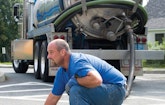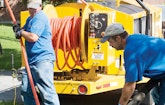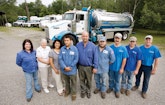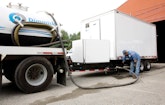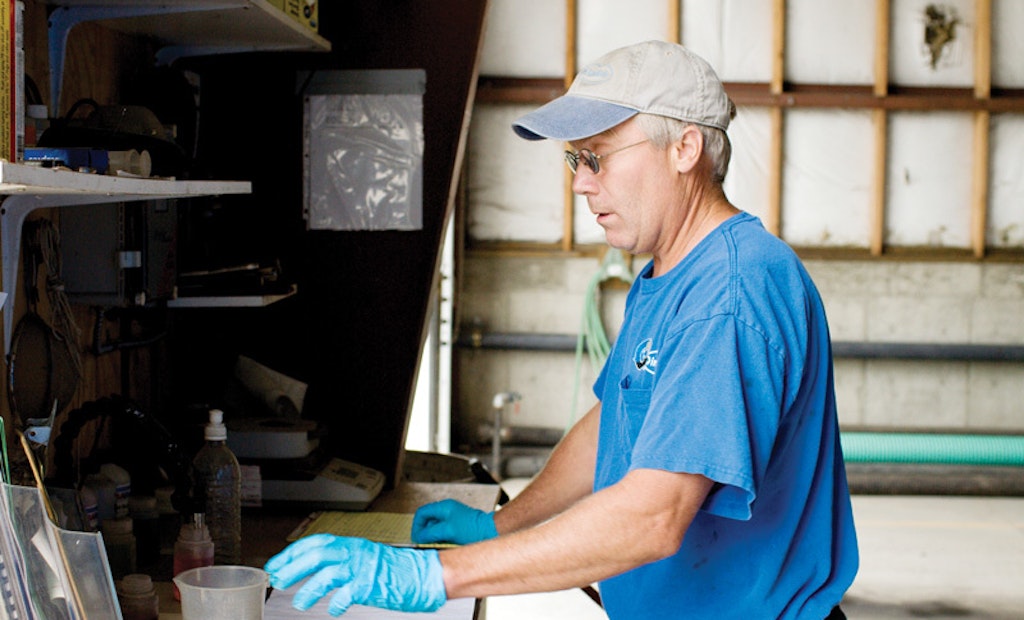Interested in Trucks?
Get Trucks articles, news and videos right in your inbox! Sign up now.
Trucks + Get AlertsDespite a challenging economy, Robert Dimmick is confident several things will always keep his business — Dimmick Wastewater Services in Randolph, Vt. — thriving like healthy bacteria in a well-maintained septic tank: great customer service, business diversity and willingness to embrace new waste-disposal technology.
“The key thing in our business is service, service, service,” says Dimmick, whose father, Russell, started the company as Central Vermont Septic Service in 1976. “We pick up new accounts every month. We’ve experienced 38 percent sales growth just this year alone, and we couldn’t do that if we didn’t provide great service.”
The best way to instill in employees a core value like customer service is to lead by example. If employees consistently heard Dimmick mouth off to a customer or saw that he accepted a job performed halfway, they’d “follow in my footsteps,” he says.
DIVERSE SERVICES
The way Dimmick sees things, offering a diverse array of services goes hand-in-hand with providing good customer service, because being a one-stop shop makes things that much easier for customers. For example, if Dimmick technicians discover a clogged lateral line while pumping out a tank, they can clean the line with a waterjetter instead of having the customer call another company and pay for another service call.
Under that philosophy, the company has assertively branched out into other lines of work. About 40 percent of the company’s sales volume comes from cleaning pipelines, the company’s most profitable service. Septic-tank pumping generates another 30 percent, septic-system inspections and engineering services contribute 20 percent, and portable sanitation represents the remaining 10 percent, Dimmick says.
“Basically, if you see a need for something and you do it for a fair price and provide good service, you’re going to stay busy,” he explains. “Diversity is extremely important. If a customer needs something taken care of, we have the equipment to take care of it. You pull in to pump a tank and find they’ve got a plugged line or a broken line and need some engineering, you can take care of it.’
DEWATERING EMPHASIS
To dispose of waste, Dimmick embraces a mobile dewatering technology. More than a decade ago, he invested $225,000 in a mobile dewatering box manufactured by Denmark-based Simon Moos Maskinfabrikt A/S that could handle 12,000 to 15,000 gallons of waste on site per day.
A typical dewatering truck vacuums septic-tank sludge into an onboard holding tank, where the solids are treated and separated. Then the biologically active water is pumped back into the septic tank, and the solid waste goes to a waste-treatment facility, or perhaps is land-applied, composted, or treated through some other alternative disposal method.
“We ran the numbers, which showed dewatering could be very profitable,” Dimmick says.
Because of economies of scale, it was most cost-effective to use the dewatering truck to service commercial accounts with large tanks, such as restaurants, rest areas and trailer parks. The company continued to pump household septic tanks with conventional vacuum trucks. At the time, the company land-applied its waste on family-owned farmland, a practice it stopped years ago.
“That’s when we really started growing,” Dimmick says of the dewatering-truck purchase. “The truck allowed us to be much more competitive in helping municipalities.”
Dimmick says even back when he first got into the industry, it didn’t make sense to him to spend all that time and money on hauling around all that water. “For example, we had one job where we’d drive two hours one way to pump out two 5,000-gallon tanks at a state rest area,” Dimmick explains. “It took us two days to do the job and land-apply the waste. With straight (vacuum) trucks, that would’ve been three trips, versus one with this truck — plus, we got other jobs at the same time along the route.
“If we ran the dewatering truck for eight to 10 hours a day, we could turn $4,500 to $6,500 in gross revenue, versus $1,000 for a conventional truck on a good day,” he continues. “And it’s beneficial to return the water into the septic tank. If you leave the tank full of water with bacteria, it’s good for the system.”
ROOTS IN PUMPING
Dimmick’s interest in promoting dewatering stems from a lifelong involvement in the septic service industry. He helped his father out a lot as a youngster, pumped his first septic tank the day he turned 16 years old and worked for his father full time until he turned 18. That’s when he bought the septic service end of the business from his father, who also sold trailers to contractors.
His career path from there was hardly conventional, however. In 1998, he sold his business to a local waste-hauling outfit that was interested in expanding its services. He stayed on as an employee for several years, bidding jobs on a commission basis. Then, in an abrupt turnaround, the same company announced it was selling its liquid-waste division. Dimmick couldn’t resist the chance to do business again with his old customers.
“There was so much demand for good service, so I started up the company again, this time as Dimmick Wastewater Service,” he says. “We got back about 98 percent of our old accounts and added another 60 percent in new accounts in the first three years. It was very overwhelming — that’s very fast growth.’’
The company is a family affair. Dimmick’s wife, Linda, handles the accounting. Their son, Billy, 17, is waiting to take over management of the portable sanitation arm of the business. Their oldest son, Bobby, 20, is studying diesel mechanics and has worked in the service end of the family business. Their daughter, Bailey, 19, also is in college, studying architecture, and has worked in the office.
“Working with family can be challenging but very rewarding,” Dimmick says. “It’s no different than anything else. Everyone has different personalities, and you’ve got to be able to overlook the little things and work together.’’
RESTROOMS VS. SEPTIC
The portable restrooms, visible around the service territory, are a calling card for the business, Dimmick believes.
“Restrooms are more of a volume business,” he notes. “You can’t have units too far apart on a service route or you start losing money quick at only $25 a week per unit. I look at portable restroom business as advertising right now. If it breaks even, I’m happy.”
Dimmick says the company services a lot of outdoor weddings, which are very popular in Vermont. Equipment includes 160 standard restrooms built by Five Peaks Technology and one 20-foot restroom trailer from Advanced Containment Systems Inc. (ACSI). The company services the restrooms with a 2008 Kenworth T300 with a 1,500-gallon waste/300-gallon freshwater steel tank, built by Quebec, Canada-based Teamco.
On the septic side of the business, the company owns a 2010 Kenworth T800 with a 4,300-gallon aluminum tank, built by LC Tanks Inc.; a 2001 Kenworth T800 roll-off truck that carries either a 3,500-gallon steel tank built by Teamco or a dewatering box; a 2000 Kenworth T600 with a 2,500-gallon steel tank, built by Teamco; a 1994 International with a 2,400-gallon steel tank, built by Teamco; a 2008 Sterling flatbed truck; and a trailer-mounted waterjetter (2,000 psi at 40 gpm) built by O’Brien Manufacturing (a division of Hi-Vac Corp.).
The company also relies on two 1994 Chevrolet service vans that each carry a homemade jetter and Ratech Electronics inspection camera; and a Heil transport tanker with a 8,000-gallon aluminum tank, built by Heil Environmental and used for transporting liquid waste for commercial and municipal accounts.
BRIGHT FUTURE
Dimmick says he’s looking forward to continued growth for the company, and would like to see all his children working together. New blood would nicely complement his existing staff, which includes employees who’ve been with the company for 16 and 12 years, respectively.
“My long-term plan is to make it an employee-owned company,’’ he says. “Maybe some of my employees’ kids would want to come in, too … it’s a nice little business, with great employees and great customers. It’s been a joy every day. I get up and look forward to going to work.”
But he warns that no matter who runs the company, it must maintain its emphasis on customer service. “It’s easy to get on top, but harder to stay on top,” he notes. “You can quickly go to the bottom by losing that customer-service emphasis.”

